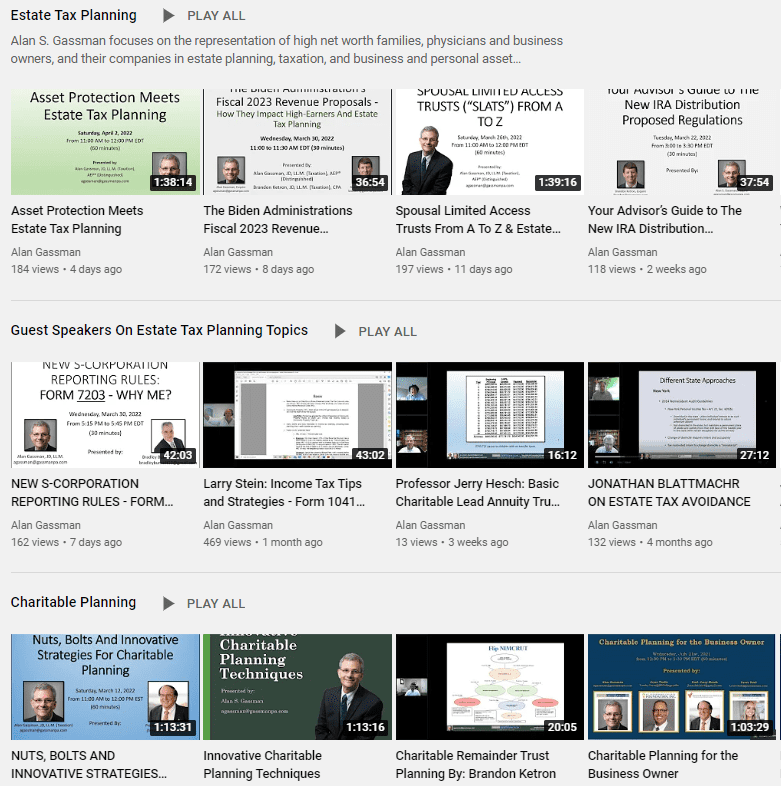|
Powers of Appointment, An Amazing Planning Tool Under the New IRA Stretch Trust Regulations
Written By: Alan Gassman, JD, LL.M and Brandon Ketron, JD, LL.M, CPA

On Tuesday, our article entitled “An Amazing Planning Tool Under New IRA Stretch Trust Regulations” was published on LISI.
The new proposed regulations on “stretching an IRA” payable to a trust generally revolutionize the ability to pick and choose what future or remainder beneficiaries of a trust can be considered to exist for stretch IRA purposes.
This will enable many families who consist of the surviving spouse and descendants to facilitate a lifetime stretch of an IRA or profit-sharing plan/401K into an account that can provide lifetime benefits for a spouse, with the remainder interest passing to the children.
Clients with short life expectancies and/or large IRA and profit-sharing balances will be best served by updating their “stretch trust” language. Now, as opposed to waiting until the permanent regulations are issued.
This, and basic information on planning with Powers of Appointment, appear in our article which is reproduced below with the permission of Leimberg Information Services. Special thanks to Stetson Law students McKenzie McAdams and Brock Exline for their dedication and hard work on this article.
EXECUTIVE SUMMARY:
On February 23, 2022, the IRS issued very extensive Proposed Regulations with a Preamble totaling 275 pages which include many valuable and positive interpretations of the SECURE Act’s changes to the rules that apply when IRAs and profit-sharing plans are payable to “Stretch Trusts.” While Proposed Regulations are not final or guaranteed to be adopted by the Treasury Department as first written, most often the provisions that are taxpayer-friendly are adopted, and the provisions that are not taxpayer-friendly may be made more favorable or clarified.
These Proposed Regulations, and an example therein, appear to allow certain remainder beneficiaries of a trust to not be considered to be beneficiaries under the stretch rules, while certain individuals can be considered to be beneficiaries under the stretch rules without being notified of the trust or being entitled to accountings or notice thereof.
The most common example of where these rules will apply, if passed, is when a Trust is left to benefit a surviving spouse, and then adult children and the family would like to get a payout from the IRA over the lifetime of the surviving spouse instead of within just over 10 years after the death of the Plan Participant. If the surviving spouse has a Power of Appointment that he or she can limit before September 30th of the year following the year of death of the Plan Participant so that it is only exercisable in favor of siblings who are no more than 10 years younger than the Plan Participant, then the following occurs:
1. The children are takers in default of the Power of Appointment but are not considered to be beneficiaries of the trust under the stretch rules, even though it is intended that they will benefit after the death of the spouse by reason of the spouse not exercising the power, and
2. The siblings and the surviving spouse are all Eligible Designated Beneficiaries, so that a lifetime payout can be based on the life expectancy of the oldest of the surviving spouse and the siblings, unless they elect to use the Plan Participant’s life expectancy under the “at least as rapidly rule” (a/k/a the “ghost rule”).
Generally, the Proposed Regulations adopt a very taxpayer-friendly view of Powers of Appointment. Essentially, an individual is permitted to hold the power to direct the passing of trust assets to one or more individuals, creditors, or charities without causing the trust to fail the identifiability requirement of See-Through Trusts, and without such permissible appointees being considered to be beneficiaries of the trust for purposes of determining required minimum distributions from the IRA/Plans, if properly drafted before death and handled after death.
Please stay tuned for our article on the ability to amend a trust after the Plan Participant’s death, which must also be drafted in view of the Proposed Regulations.
FACTS:
The Basics
A Power of Appointment is a right given to an individual in a non-fiduciary capacity (the “Powerholder”) to direct how trust assets will pass. There are two ways to characterize a Power of Appointment: (1) When the power can be exercised, and (2) how the power can be exercised.
I. When The Power Can Be Exercised
A Power of Appointment can be exercised (a) during the lifetime or upon the death of the Powerholder, or (b) only after the death of the Powerholder. These are called Lifetime Powers of Appointment and Testamentary Powers of Appointment.
A “Lifetime Power of Appointment” will normally provide the individual Powerholder with the ability to direct where Trust assets will be paid at any time during their lifetime. A “Testamentary Power of Appointment” is exercisable only upon the death of the Powerholder.
II. How the Power Can Be Exercised.
A Power of Appointment can also vary in the extent to which the power can be exercised. A Powerholder either has unrestricted power to direct the passage of trust assets or is limited to a certain group or class of beneficiaries to whom the Powerholder can direct assets to. The two types of Power of Appointments under this category are “General Powers of Appointment” and “Limited Powers of Appointment.”1
Example – General Power of Appointment
Jack creates a trust and directs the trustee to pay the income to his child, Sally, for Sally’s life. Upon Sally’s death, the property is to pass to Sally’s children. Sally is given the power to appoint the property to her own estate upon her death. If she exercises the power, the property will pass pursuant to the terms of Sally’s Last Will and Testament (rather than pursuant to the terms of the trust). Sally possesses a testamentary general Power of Appointment – even though she does not personally benefit from the exercise of the Power of Appointment.
Example – Limited Power of Appointment
Jack creates a trust to pay the income to Sally for life and then to pay the remainder to Sally’s children. Jack also gives Sally the power to make distributions for the health, education, maintenance and support of Sally’s husband, Steve, during her lifetime. Sally holds a lifetime limited Power of Appointment – her power to distribute is limited by an ascertainable standard relating to the health, education, maintenance or support of her husband. Sally may not exercise the power in favor of herself, her estate, her creditors, or creditors of her estate.
Other Power of Appointment Considerations
Powers of Appointment are used for many reasons, including to give trusted family members the ability to redirect how trust assets may pass, and for generation-skipping tax planning situations where a family has large trusts that may be subject to the federal generation-skipping tax. A power given to a beneficiary to direct trust assets to creditors, or creditors of his or her estate, can be used to avoid imposition of federal generation-skipping tax on the death of a beneficiary.2
In addition, a Power of Appointment may be used to facilitate a step-up in basis for appreciated assets held in trust. The mere possession of a General Power of Appointment over an appreciated asset at the time of the decedent’s death can cause such property to be included in the Powerholder’s estate irrespective of whether the power was actually exercised. The basis in the property will “step up” to the fair market value of the property at the decedent’s death, thus when the property is later sold the possible capital gain on the property will be far less than if the property had the lower basis.3
Under certain circumstances, planners may also give independent parties who are not fiduciaries the ability to convert Limited Powers of Appointment to General Powers of Appointment in order to provide for a step-up in basis if the estate tax is not a concern.
It is noteworthy that a Power of Appointment can exist and be considered to be exercisable under the Treasury Regulations for income tax and estate tax purposes, notwithstanding that it can only be effective if approved by one or more independent persons (“non-adverse parties”) whose power of approval is not subject to a fiduciary duty.4
For example, giving an elderly individual the power to direct assets to creditors of her estate could be somewhat dangerous as there is a risk that someone might take advantage of her and have her sign a promissory note to them and subsequently appoint assets in the Trust upon her death to pay the note.
If long-time friends or neighbors have the power to approve or veto the exercise of the power on a non-fiduciary basis, then it is still considered fully effective under IRC §2041(b)(1)(B). As such, it can be presumed that such a scheme will also be considered to be effective under the stretch IRA rules.
Language that can assist in ensuring that the power remains fully effective when such individuals are appointed where a power cannot be exercised is as follows:
Notwithstanding the above, such power may not be exercised without the written consent of at least two (2) of the five individuals named below, with such approval power being exercisable by any one (1) or more of them without any fiduciary duty to act or not act in any particular manner, provided that if for any reason it is determined that a fiduciary duty exists, then such power shall nevertheless be exercisable, notwithstanding such duty.
Non-GST Trust Planning
Power of Appointment and stretch trust planning considerations also comes about for large estates when assets will be allocated to a “Non- Generation Skipping Trust” for descendants. where the trust assets should be considered as owned by the children of the decedent for federal estate tax purposes to avoid imposition of Federal Generation Skipping Tax on the death of a child. It would be a waste to allocate IRA or profits sharing “income with respect to a decedent” to the GST share.
Most readers know that if an estate exceeds the Generation Skipping Exemption of a decedent, which is as much as $12,060,000 this year, the Exemption Amount can pass to a GST Trust that will not be subject to estate tax in the estates of the children of the decedent, but that excess amounts held in trust will be subject to Generation Skipping Tax on the death of the children after being allocated to a “Non GST Trust” if not included in their estates for estate tax purposes.
Normally planners will provide the child with a testamentary Power of Appointment in favor of creditors of the child’s estate under a Non GST Trust in order to cause inclusion of trust assets in the child’s estate to avoid the imposition of GST Tax, but when See-Through Trust status was desired to qualify for a lifetime payout before the SECURE Act the there was a question as to whether a Power of Appointment exercisable in favor of “creditors of the estate of the Primary Beneficiary who are people no older than the Primary Beneficiary” would result in loss of the ability to stretch payments over the lifetime of the Primary Beneficiary. Under these new Proposed Regulations and the Secure Act it appears that it will not be problematic to provide for a Power of Appointment held by a designated beneficiary (or an Eligible Designated Beneficiary) to be payable to creditors of his or her estate without causing loss of the ability to qualify for a 10-year stretch, or a life expectancy stretch if the power holder is an Eligible Designated Beneficiary and the trust is otherwise properly designed and drafted.
See-Through Trusts
A popular tax planning tool for IRA and Pension Plan owners is the use of See-Through Trusts. A See-Through Trust is a trust that acts as the beneficiary of a Plan Participant’s retirement account. The Plan Participant makes the beneficiaries of the trust the individuals for whom the Plan Participant wishes to pass such assets. See-Through Trusts get their name because you can “see-through” the trust to the underlying beneficiaries. However, to qualify as a See-Through Trust, the underlying beneficiaries must be identifiable.
With reference to the identifiability requirement for See-Through Trusts, the Proposed Regulations provide that “if it is possible to identify each person eligible to receive a portion of … the plan through the trust” the requirement is met. Previously, the presence of a Power of Appointment (whether or not it was exercisable in favor of creditors, charities, or other “non-persons”) was thought by many to possibly cause such requirement to not be met because the failure of the Powerholder to exercise or restrict such power resulted in the inability to determine who the beneficiaries are, particularly when such Power was not limited to a specific class of beneficiaries. In addition, if the power was exercisable in favor of creditors, charities, or other “non-persons,” they would be viewed as beneficiaries of the trust, and thus cause the IRA/Plan to be considered to have a non-individual beneficiary and subject to less favorable payout rules. Many planners’ documents contained specific language to provide that the Power of Appointment could only be exercised in favor of individuals that were younger than the Powerholder to prevent the permissible appointment of trust assets in favor of an older beneficiary that might impact the ability to stretch distributions out over the lifetime of the oldest beneficiary of the trust.
The Proposed Regulations, however, provide a safe harbor for See-Through Trusts by identifying the beneficiaries when a Power of Appointment exists.
COMMENTS:
Under the Proposed Regulations, the mere existence of a Power of Appointment will not cause the trust to fail the identifiability requirement. Rather, Powers of Appointment would be treated in three different ways depending upon the applicable circumstances. Each of the circumstances is relative to whether the power was exercised or restricted as of September 30th in the calendar year following the calendar year in which the Plan Participant died (the “Determination Date”).
1. Power Exercised or Restricted by Determination Date.
If the Powerholder exercises or restricts the power prior to the Determination Date, the persons who benefit as a result of such exercise are considered to be beneficiaries of the trust.
Alternatively, the power may be restricted to only be exercisable in favor of only two or more identifiable beneficiaries before the Determination Date, in which case the permissible appointees under the restricted power are considered to be the beneficiaries of the trust.
Specifically, the Proposed Regulation reads as follows:
Power of Appointment – (A) Exercise or release of Power of Appointment by September 30.
A trust does not fail to satisfy the identifiability requirements of this paragraph (f)(5) merely because an individual (powerholder) has the power to appoint a portion of the employee’s interest to one or more beneficiaries that are not identifiable within the meaning of paragraph (f)(5)(i) of this section. If the Power of Appointment is exercised in favor of one or more identifiable beneficiaries by September 30 of the calendar year following the calendar year of the employee’s death, then those identifiable beneficiaries are treated as beneficiaries designated under the plan. The preceding sentence also applies if, by that September 30, in lieu of exercising the Power of Appointment, the powerholder restricts it so that the power can be exercised at a later time in favor of only two or more identifiable beneficiaries (in which case, those identified beneficiaries are treated as beneficiaries designated under the plan).
2. Failure to Exercise or Restrict Power by Determination Date.
If the Powerholder does not exercise the power by the Determination Date in favor of one or more beneficiaries that are identifiable, or the power is not so restricted, then each Taker in Default (each person who would be entitled to the portion subject to the power if that power is not exercised) is treated as a beneficiary of the IRA/Plan Owner.
Specifically, the Proposed Regulation reads as follows:
However, if, by September 30, the Power of Appointment is not exercised (or restricted) in favor of one or more beneficiaries that are identifiable within the meaning of paragraph (f)(5)(i) of this section, then each taker in default (that is, any person that is entitled to the portion that represents the employee’s interest in the plan subject to the Power of Appointment in the absence of the powerholder exercising the power) is treated as a beneficiary designated under the plan.
3. Power Exercised or Restricted after Determination Date.
If the Powerholder fails to exercise or restrict the power prior to the Determination Date, but instead does so after the Determination Date, then those who it is exercised in favor of will be treated as beneficiaries of the trust, and the trust must be “re-tested” to determine the new payout schedule for required minimum distributions.
Specifically, the Proposed Regulation reads as follows:
(B) Exercise of Power of Appointment after September 30 of the calendar year following the calendar year of the employee’s death.
If an individual has a Power of Appointment to appoint a portion of the employee’s interest to one or more beneficiaries and the individual exercises the Power of Appointment after September 30 of the calendar year following the calendar year of the employee’s death, then the rules of paragraph (f)(5)(iv) of this section apply with respect to any trust beneficiary that is added pursuant to the exercise of the Power of Appointment.
(f)(5)(iv) Addition of beneficiary after September 30.
If, after September 30 of the calendar year following the calendar year of the employee’s death, a trust beneficiary described in paragraph (f)(3) of this section is added as a trust beneficiary (whether through the exercise of a Power of Appointment, the modification of trust terms, or otherwise), then—
(A) The addition of the beneficiary will not cause the trust to fail to satisfy the identifiability requirements of this paragraph (f)(5);
(B) Beginning in the calendar year after the calendar year in which the new trust beneficiary was added, the rules of § 1.401(a)(9)-5(f)(1) will apply taking into account the new beneficiary and all of the beneficiaries of the trust that were treated as beneficiaries of the employee before the addition of the new beneficiary; and
(C) Subject to paragraph (f)(5)(v) of this section, the rules of paragraphs (b) and (e)(2) of this section and § 1.401(a)(9)-5(f)(2) will apply taking into account the new beneficiary and all of the beneficiaries of the trust that were treated as beneficiaries of the employee before the addition of the new beneficiary.
The following examples provided by the authors, which are based on examples in the Proposed Regulations, demonstrate the aforementioned scenarios.
Our Example One – Restriction of Power of Appointment Prior to Designation Date
Dad died in 2022 at the age of 60. Dad named a See-Through Trust as a beneficiary of his IRA. Under the terms of the trust, all trust income is payable to Dad’s surviving spouse, Mom, and Mom has a Power of Appointment to redirect the trust assets upon her death. The Power of Appointment provides that, if Mom does not exercise the power, then upon Mom’s death, Dad’s descendants, per stirpes, are entitled to the remainder interest. As of the date of Dad’s death, Dad has two adult children, Child 1 and Child 2.
Before the Determination Date, Mom irrevocably restricts Mom’s Power of Appointment so that Mom may only exercise the power to appoint in favor of Mom’s siblings (who all are less than 10 years younger than Dad and thus, are Eligible Designated Beneficiaries).
Because Mom timely restricted the Power of Appointment so that Mom may exercise the power only in favor of Mom’s siblings, the only designated beneficiaries are Mom and Mom’s siblings, even though Child 1 and Child 2 are the Takers in Default. Because all of the designated beneficiaries are Eligible Designated Beneficiaries, payments may be made over Mom’s life expectancy.
Our Example Two – Restriction of Power of Appointment Prior to Designation Date
A See-Through Trust established on the death of the Plan Participant benefits a surviving spouse, and children of the Plan Participant who are over the age of 21 after the death of the surviving spouse. The surviving spouse has a limited Power of Appointment. This structure will cause the Trust to be subject to the 10-Year Rule. In order to qualify for a lifetime payout instead of the 10-Year Rule apply, only Eligible Designated Beneficiaries must be considered the beneficiaries of the Trust. Since the adult children are Non-Eligible Designated Beneficiaries, the lifetime payout is not allowed and the 10-Year Rule applies. To remedy this issue, the surviving spouse’s Power of Appointment can be restricted before the September 30th Designation Date to provide that the surviving spouse may only appoint assets to the Plan Participant’s surviving brother, who is less than ten years younger than the Plan Participant and is, therefore, an Eligible Designated Beneficiary.
Now the Life Expectancy Payout Method can be used instead of the 10-Year Rule. The practical implications of this must also be considered. While this would allow for a more advantageous payout for tax purposes, the surviving spouse would lose the ability to redirect or reallocate how the Trust assets pass upon her death between the children. For example, if one child fell out of favor, or another child needed a larger percentage of the assets, and the Power of Appointment was modified or restricted as provided above, then the surviving spouse could not exercise the power to accomplish this reallocation. There may however be non-IRA assets over which the surviving spouse could have a Power of Appointment in favor of the children and could accomplish the reallocation via exercise of the power over non-IRA assets.
Our Example Three – Failure to Exercise or Restrict Power of Appointment Prior to Designation Date
Assuming the same facts as Example One above, if Mom did not timely restrict the Power of Appointment, then Mom, Child 1 and Child 2 would all be considered designated beneficiaries and the 10-Year Rule would apply since not all designated beneficiaries are Eligible Designated Beneficiaries.
As illustrated by the above examples, the restriction of a Power of Appointment can be useful to ensure that the Life Expectancy Payout Method applies for Eligible Designated Beneficiaries by restricting its exercise to only be in favor of Eligible Designated Beneficiaries, even if the takers in lieu of exercise of such power are Non-Eligible Designated Beneficiaries.
Drafting and Interpretation Issues?
As mentioned above, the Proposed Regulations provide that when a Powerholder restricts the Power of Appointment so that the power can be exercised at a later time in favor of only two or more identifiable beneficiaries, then those identifiable beneficiaries are treated as beneficiaries designated under the Plan, and the takers in default can be ignored for stretch trust rule purposes.
This particular section of the Proposed Regulations may leave practitioners with questions regarding the status of potential takers in default.
Based on the plain reading of the language, the Proposed Regulations seem to provide that the mere act of restricting a Power of Appointment prior to the Determination Date to be exercisable in favor of two or more “identifiable beneficiaries” will cause those identifiable beneficiaries to be considered to be beneficiaries of the trust (even though they are not actually beneficiaries for state law purposes, and may therefore not be entitled to be told about the existence of the trust, to receive accountings with respect to the trust, or to otherwise have the rights that are accorded to beneficiaries under state law).
However, a question arises as to whether the “Takers in Default” of the Power of Appointment will be counted as beneficiaries under these rules if they can only benefit after the death of the powerholder if the Power of Appointment is not exercised. Generally takers in default, as second tier beneficiaries, would be included in the calculation – are they simply disregarded upon restriction of the Power of Appointment?
An example provided in the Proposed Regulations is in accordance with that result.5
The example, in its entirety, reads as follows:
(A) Facts related to plan and beneficiary. Employer N maintains a defined contribution plan, Plan Y. Employee F, an employee of N, died in 2022 at the age of 60. F named a testamentary trust (Trust Q), which was established under F’s will, as the beneficiary of all amounts payable from F’s account in Plan X after F’s death. Trust Q satisfies the see-through trust requirements of paragraph (f)(2) of this section.
(B) Facts related to trust. Under the terms of Trust Q, all trust income is payable to F’s surviving spouse, G, and G has a Power of Appointment to name the beneficiaries of the residual in Trust Q. The Power of Appointment provides that, if G does not exercise the power, then upon G’s death, F’s descendants are entitled to the remainder interest in Trust Q, per stirpes. As of the date of F’s death, F has two children, K and L, who are not disabled or chronically ill and who are both older than age 21. Before September 30 of the calendar year following the calendar year in which F died, G irrevocably restricts G’s Power of Appointment so that G may exercise the power to appoint the remainder beneficiaries of Trust Q only in favor of G’s siblings (who all are less than 10 years younger than F and thus, are eligible designated beneficiaries).
(C) Analysis. Pursuant to paragraph (f)(5)(ii)(A) of this section, because G timely restricted the Power of Appointment so that G may exercise the power to appoint the residual interest in Trust Q only in favor of G’s siblings, the designated beneficiaries are G and G’s siblings. Because all of the designated beneficiaries are eligible designated beneficiaries, annual life expectancy payments are permitted under section 401(a)(9)(B)(iii). Note, however, that because § 1.401(a)(9)-5(e) applies, a distribution of the remaining interest is required by no later than 10 years after the calendar year in which the oldest of G and G’s siblings dies.
Based on the above example from the IRS, F’s descendants, K and L would be the takers in default. Here, G timely restricted the Power of Appointment in favor of only G’s siblings and the restriction resulted in only G and G’s siblings being counted as designated beneficiaries under the Plan.
The above example does not explicitly mention what happens to the takers in default but seems to provide that the restriction eliminates them from being included as beneficiaries of the trust.
Alternatively, the Proposed Regulations could be interpreted to provide that those beneficiaries who are potential appointees under a restricted Power of Appointment are considered as “countable” for purposes of determining the post-death payout schedule as well as the takers in default, unless or until the Power of Appointment is actually exercised. Under this interpretation, regardless of a restriction put on a Power of Appointment in favor of two or more identifiable beneficiaries, unless the power is exercised in their favor, the takers in default will be used in determining the post-death payout schedule. However, this interpretation conflicts with the language of the example provided in the Proposed Regulations.
It is also not clear what happens if the Power of Appointment is restricted only in favor of one identifiable beneficiary prior to the Designation Date. The Proposed Regulations state that if the Powerholder “restricts [the power] so that the power can be exercised at a later time in favor of only two or more identifiable beneficiaries…” [emphasis added], then the permissible appointees under the Power are considered the beneficiaries and not the takers in default. But what if the Power is restricted to only permit the appointment to one identified individual, such as the spouse’s brother who is not more than ten years younger than the Plan Participant? Are the takers in default also considered to be beneficiaries because the power is not exercisable in favor of two or more beneficiaries? Is the brother the only beneficiary of the trust for purposes of the required minimum distribution rules, and this is just a drafting error? The Preamble and the actual text of the Proposed Regulations appear to be in conflict on this.
The Preamble indicates that “[s]pecifically, these proposed regulations provide that if, by September 30 of the calendar year following the calendar year of the employee’s death, the power is exercised in favor of one or more beneficiaries that are identifiable or is restricted so that any appointment made at a later time may only be made in favor of one or more identifiable beneficiaries, then all of those identifiable beneficiaries are taken into account as beneficiaries of the employee.” [emphasis added]
It appears that the Preamble expected the Proposed Regulation language to require the power to be restricted so that a Power of Appointment could only be exercised in favor of “one or more” individuals while the actual text of the Proposed Regulations provides that the power must be restricted in “favor of only two or more” individuals. The authors believe that these conflicting provisions are mistakes in the drafting of the provisions rather than intentional conflicts.
Hopefully, this will be cleared up in the final regulations after comments have been made.
Addition of Beneficiary After Designation Date
The Proposed Regulations also provide a new rule that applies when a beneficiary is added who was not initially taken into account in determining the IRA/Plan Owner’s beneficiaries.
Under this rule, if a beneficiary is added after the Determination Date, then the eligibility of the See-Through trust is re-evaluated alongside the RMD method that is utilized. The rules regarding multiple designated beneficiaries6 must be applied when evaluating the effect of the newly added beneficiary along with all of the beneficiaries that were taken into account before the addition of the new beneficiary.7
Alternatively, if the addition of the beneficiary would cause a full distribution of the employee’s interest in the plan to be required pursuant to Section 401(a)(9)(H) during the calendar year in which the beneficiary is added or in an earlier calendar year, then the Proposed Regulations provide that the full distribution is not required until the end of the calendar year following the calendar year in which the beneficiary was added.
CONCLUSION:
The Proposed Regulations are 275 pages of the IRS’s attempt at clarifying portions of the SECURE Act. However, some of the provisions of the Proposed Regulations are not as clear as they thought. As aforementioned, the text of the Preamble and of the Proposed Regulations appear to conflict in regard to restricting Powers of Appointment. The authors hope that such provisions that are sources of confusion are addressed at the June 15th public hearing.
That being said, the time to update trust language may be now rather than later. Planners should not wait until the final regulations are issued to revise trust language because the significant changes that are found in the Proposed Regulations are likely to be retained. As the Preamble provides, “taxpayers must apply the existing regulations” in addition to considering “a reasonable, good-faith interpretation of the amendments made by sections 114 and 401 of the SECURE Act.” Thus, revisions of trust language pursuant to a reasonable interpretation of the Proposed Regulations are permitted.
2 See Blattmachr, Rivlin & Slade, “Selected Planning and Drafting Aspects of Generation-Skipping Transfer Taxation,” for an in-depth discussion on the use of Powers of Appointment in generation-skipping tax planning situations. https://shenkmanlaw.com/uploads/2021/04/Generation-Jumping-Selected-Planning-and-Drafting-Aspects-of-Generation-Skipping-Transfer-Taxation-2.pdf. Jonathan Blattmachr is said to have invented the Power of Appointment just after inventing the installment sale to the grantor trust. His presentations on Powers of Appointment are unsurpassed.
3 See Ed Morrow on PLR 202206008: Judicial Settlement Modification & Formula Testamentary General Powers of Appointment. Leimberg Information Services. March 17, 2022. https://www.leimbergservices.com/openfile.cfm?filename=c:inetpubwwwrootalllis_notw_2946.html&fn=lis_notw_2946
4 See IRC § 2041. See also Blattmachr, Rivlin & Slade, “Selected Planning and Drafting Aspects of Generation-Skipping Transfer Taxation,” Financial Planning Thoughts 1996. “A person is treated as holding a general (taxable) Power of Appointment under IRC § 2041 even if it is exercisable with the consent of a non-adverse party (that is, someone other than one whose interest would be adversely affected by the exercise of the power; an example of someone adversely affected would be a taker-in-default of the exercise of the power)” https://shenkmanlaw.com/uploads/2021/04/Generation-Jumping-Selected-Planning-and-Drafting-Aspects-of-Generation-Skipping-Transfer-Taxation-2.pdf
5In the example, a 60-year old Plan Participant dies leaving an IRA or pension account to a properly drafted Accumulation Trust for the lifetime benefit of his surviving spouse, with the remainder of the trust to pass to his two children who are not disabled or chronically ill and are both older than age 21. Before September 30 of the calendar year following the year in which the participant died the surviving spouse irrevocably restricts her Power of Appointment to be exercisable only in favor of siblings who were less than 10 years younger than the Plan Participant “and thus, are eligible Designated Beneficiaries.” The example concludes that the children are the “Takers in Default” under the Power of Appointment and are not counted as beneficiaries.
7 Instead of determining the applicable denominator using the beneficiary with the shortest life expectancy, the Proposed Regulations provide that the applicable denominator is determined using the life expectancy of the oldest designated beneficiary. The Proposed Regulations also provide that whether a full distribution is required is generally determined using the oldest of the designated beneficiaries. By example, if an employee has multiple eligible designated beneficiaries who are born in the same calendar year, then full distribution of the employee’s remaining interest generally is required by the tenth calendar year following the death of the oldest designated beneficiary.
LISI Employee Benefits & Retirement Planning Newsletter #783 (April 5, 2022) at http://www.leimbergservices.com Copyright 2022 Leimberg Information Services, Inc. (LISI). All rights reserved. Reproduction in Any Form or Forwarding to Any Person Prohibited Without Express Permission. This newsletter is designed to provide accurate and authoritative information regarding the subject matter covered. It is provided with the understanding that LISI is not engaged in rendering legal, accounting, or other professional advice or services. If such advice is required, the services of a competent professional should be sought. Statements of fact or opinion are the responsibility of the authors and do not represent an opinion on the part of the officers or staff of LISI.
|

























